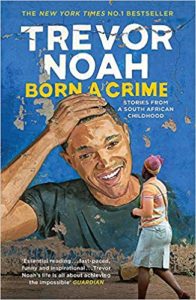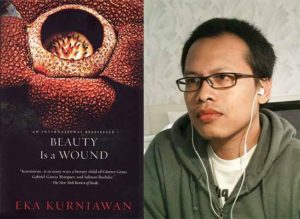Trevor Noah
Comedian and Daily Show talk show host Trevor Noah’s autobiography Born a Crime is a moving, at times funny, at times brutal and hardhitting account of his childhood in South Africa. Born to Patricia Nombuyiselo Noah, a Xhosa, who chose to have Trevor out of wedlock with a Swiss man made Patricia a criminal. For her crime as a native female was to have “illicit carnal intercourse” with a European white male as stated by the Immorality Act, 1927. She made a fine mother and being a single parent had its share of ups and downs.
Born a Crime is to be turned into a biopic with Lupita Nyong’o playing the role of Patricia.
Here is a powerful extract from Born a Crime when Trevor recounts how his mother taught him to read and be independent.
****
My mom told me these things so that I’d never take for granted how we got to where we were, but none of it ever  came from a place of self-pity. “Learn from your past and be better because of your past,” she would say, “but don’t cry about your past. Life is full of pain. Let the pain sharpen you, but don’t hold on to it. Don’t be bitter.” And she never was. The deprivations of her youth, the betrayals of her parents, she never complained about any of it.
came from a place of self-pity. “Learn from your past and be better because of your past,” she would say, “but don’t cry about your past. Life is full of pain. Let the pain sharpen you, but don’t hold on to it. Don’t be bitter.” And she never was. The deprivations of her youth, the betrayals of her parents, she never complained about any of it.
Just as she let the past go, she was determined not to repeat it: my childhood would bear no resemblance to hers. She started with my name. The names Xhosa families give their children always have a meaning, and that meaning has a way of becoming self-fulfilling. …
When it was time to pick my name, she chose Trevor, a name with no meaning whatsoever in South Africa, no precedent in my family. It’s not even a Biblical name. It’s just a name. My mother wanted her child beholden to no fate. She wanted me to be free to go anywhere, do anything, be anyone.
She gave me the tools to do it as well. She taught me English as my first language. She read to me constantly. The first book I learned to read was the book. The Bible. Church was where we got most of our other books, too. My mom would bring home boxes that white people had donated — picture books, chapter books, any book she could get her hands on. Then she signed up for a subscription program where we got books in the mail. It was a series of how-to books. How to Be a Good Friend. How to Be Honest. She bought a set of encylopedias, too; it was fifteen years old and way out of date, but I would sit and pore through those.
My books were my prized possessions. I had a bookshelf where I put them, and I was so proud of it. I loved my books and kept them in pristine condition. I read them over and over, but I did not bend the pages or the spines. I treasured every single one. As I grew older I started buying my own books. I loved fantasy, loved to get lose in worlds that didn’t exist. I remember there was some book about white boys who solved mysteries or some shit. I had no time for that, Give me Roald Dahl. James and the Giant Peach, The BFG, Charlie and the Chocolate Factory, The Wonderful Story of Henry Sugar. That was my fix.
I had to fight to convince my mom to get the Narnia books for me. She didn’t like them.
“this lion,” she said, “he isa false God — a false idol! You remember what happened when Moses came down from the mountain after he got the tablets . . .”
“Yes,, Mom,” I explained, “but the lion is a Christ Figure. Technically, he is Jesus. It’s a story to explain Jesus.”
She wasn’t comfortable with that. “No, no. No false idols, my friend.”
Eventually I wore her down. That was a big win.
If my mother had one goal, it was to free my mind. My mother spoke to me like an adult, which was unusual. In South Africa, kids play with kids and adults talk to adults. The adults supervise you, but they don’t get down on your level and talk to you. My mom did. All the time I was like her best friend. She was always telling me stories, giving me lessons, Bible lessons especially. She was big into Psalms. I had to read Psalms every day. She would quiz me on it. “What does that passage mean? What does it mean to you? How do you apply it to your life?” That was every day of my life. My mom did what school didn’t. She taught me how to think. (pp. 66-68)
****
Buy it on Amazon



